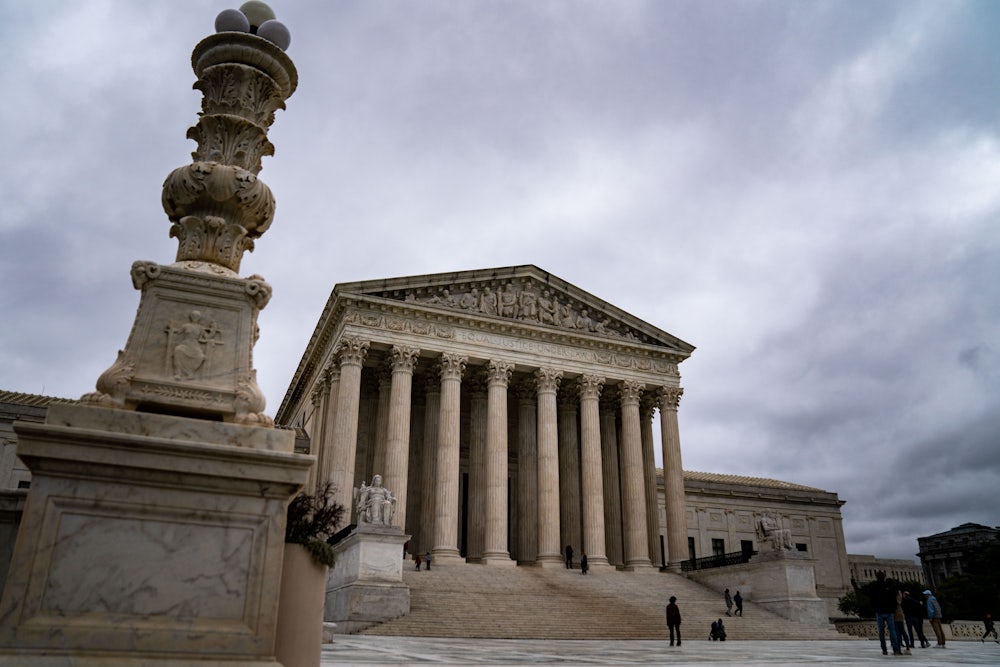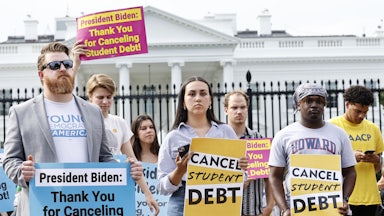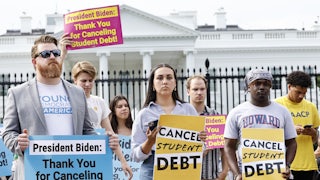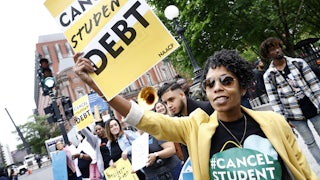The Supreme Court will now hear two cases about President Joe Biden’s student loan debt relief order next year. Both cases hope to end the current program, which has been blocked by lower courts before it can go into effect. While the justices might ultimately rule in favor of the order, the addition of the second case this week might offer them a more insincere way to nix it.
The Biden administration’s order would, if it takes effect, wipe out up to $20,000 in student loan debt from many debtors. Who qualifies for full relief would depend on factors like income—it generally applies to those with an annual salary below $125,000 if single and $250,000 for married couples—and whether they also had Pell grants. Only debt owned by the federal government falls under the program’s scope. By some estimates, relief could affect as many as 20 million Americans and wipe out $400 billion in federal student debt.
Biden v. Nebraska, the first case to alight on the high court’s docket, pits the federal government against six state governments, all of which have Republican attorneys general. Nebraska, joined by Arkansas, Iowa, Kansas, Missouri, and South Carolina, sued the administration this fall to block the order from going into effect. The states argue that Biden’s order is based on a misreading of the Heroes Act of 2003, which gave the Department of Education the power to suspend or forgive student loan debt in national emergencies. Though originally passed with the Iraq War in mind, its text is much broader.
The state lawsuit frames Biden’s order as part of a larger pattern of overreaching executive orders, something that might garner sympathy from the court’s six conservative justices. “The Administration is once again invoking the COVID-19 pandemic to assert power far beyond anything Congress could have conceived,” the states argued in a reply brief this fall. “Previously, this court stopped CDC’s eviction moratorium. Later, it stayed OSHA’s vaccine-or-test mandate. Now, while President Biden publicly declares the pandemic over, the Secretary and Department of Education are using COVID-19 to justify the mass debt cancellation.”
In legal terms, the states argued that Biden’s order goes beyond what the Heroes Act authorized. They argued that it “does not authorize this sweeping action of great economic and political significance,” alluding to the court’s ruling last term in West Virginia v. EPA, in which the court struck down a carbon emissions regulation because Congress had not spoken “clearly” enough on the matter. The states also contend that Biden’s order is illegal under the Administrative Procedures Act, a procedural statute that we’ll come back to in a minute.
The Biden administration has argued that the Heroes Act’s broad language and subsequent amendments show that Congress intended to give presidents—well, more specifically, the secretary of education—the power to discharge large amounts of student debt during national emergencies. “The Secretary’s plan lies within the heartland of his statutory authority to administer federally held loans in a federal student-loan program,” the Justice Department told the justices in a request to intervene last month. “He does not claim any authority to ‘intrude into an area that is the particular domain of state law’ or to impose novel requirements on regulated parties.”
Another hurdle for the states to overcome is standing. A range of lawsuits against Biden’s order have failed in the lower courts because the litigants who brought them couldn’t sufficiently prove that they had been harmed by the order. There’s a sort of obvious logic to this: You can’t claim you’re being directly injured by the federal government when the federal government is actively improving your financial situation. Many Republicans initially conceded that legal challenges would be difficult to bring and some too-clever-by-half attempts to get around the standing issue have previously failed.
The states argue, however, that they have standing because the order would allegedly cause financial harm to the Missouri Higher Education Loan Agency, or Mohela, a nonprofit organization that services federal student loan debt across the country. The states argued that Mohela, which was created by the Missouri legislature, is a state appanage of sorts and thus gives standing to the state itself. The Biden administration countered that courts have previously treated Mohela as a distinct entity because of its legal and fiscal independence from the state of Missouri itself, including the ability to sue and be sued on its own accord. A federal district court dismissed the lawsuit on standing grounds, but the Eighth Circuit Court of Appeals reversed that decision and blocked the Biden administration from carrying out the program nationwide.
The Supreme Court agreed to hear a second lawsuit, Department of Education v. Brown, earlier this week. The two litigants, Myra Brown and Alexander Taylor, also want the Supreme Court to gut Biden’s order. They claimed that they were injured by the way in which the Biden administration crafted the student debt relief order, and asked the Supreme Court to overturn it on those grounds.
“[Brown] does not qualify for debt forgiveness because the Program does not cover commercially held federal student loans that are not in default, and [Taylor] does not qualify for the full amount of debt forgiveness because he did not receive a Pell Grant when he was in college,” they told the Supreme Court in a filing earlier this month. “[They] believe it is irrational, arbitrary, and unfair to exclude Brown from the Program just because her debt is commercially held and not in default, and to calculate the amount of debt forgiveness Taylor receives based on the financial circumstances of his parents.”
The debtors’ case hinges on the Administrative Procedures Act, or APA, and the Biden administration’s alleged defiance of it. The APA is a metastatute of sorts that lays out how federal agencies must develop and write new rules and regulations to enforce other statutes. An entire field of law—appropriately known as administrative law—is dedicated to studying the APA to the numerous federal agencies and circumstances where it applies. Suffice it to say, for our purposes that the Biden administration, in the debtors’ eyes, allegedly ran afoul of the APA by ignoring its notice-and-comment requirements.
A casual observer might think that Brown and Alexander are suing in the hopes that the Biden administration will redo the order and include them. Their argument is framed in the possibility that they could also obtain relief for the Biden administration’s illegal haste. A federal district court in Texas even ruled that they had standing because they “lost the chance to obtain more debt forgiveness, which flows directly from [the Department’s] promulgation of the program’s eligibility requirements that failed to undergo a notice-and-comment period.”
There are good reasons to doubt this narrative, which would conveniently allow the Supreme Court to torpedo Biden’s order under the premise that it didn’t help enough people. For one, the two debtors argued that the Heroes Act does not allow Biden to issue the debt relief order at all, and that even if it did, the program is too “broad and untailored” to its purpose because it covers people who would not necessarily be at risk of imminent bankruptcy because of the pandemic. In other words, a lawsuit that purports to seek to broaden student loan debt relief finds itself in the strange position of trying to narrow it.
The two plaintiffs, Brown and Taylor, also appear to have been recruited by the Job Creators Network Foundation, a right-wing advocacy group. While its brief insinuates that the two debtors hope to have their own debts relieved by the Biden administration in another form, JCNF itself describes the lawsuit in much different terms. “Biden’s student loan bailout is fundamentally unfair to the tens of millions of Americans who never went to college or paid their loans back and are now on the hook for paying back this debt through their taxes,” the group argued on its web page about the litigation. This does not sound like a case brought by people who want student loans to be forgiven.
It’s worth noting that the Biden student debt order is not necessarily doomed at the Supreme Court. As I’ve noted before, there are good arguments for its legality and for the lack of legal standing by its opponents. And, technically speaking, the justices took up both cases at the Biden administration’s request—the Justice Department asked the high court to do so while urging the justices to block injunctions by the lower courts. The Supreme Court has previously rejected requests to hear other cases where anti-relief plaintiffs had been dismissed by lower courts. But if the justices are inclined to overturn Biden’s order, the addition of Department of Education v. Brown gives them a dubious and potentially disingenuous vehicle to do it.










